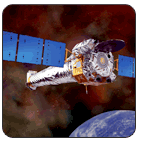
The Universe Forum has assembled
a selection of web resources from our NASA space science mission partners
that offer more information about the key topics of “Inside Einstein’s Universe.” From
the Big Bang to black holes, Einstein’s legacy is pushing the frontiers
of astronomy to new limits.
Beyond Einstein: From the Big Bang to Black Holes
The discoveries
of Albert Einstein sparked the scientific revolution of the 20th century
and rank among the greatest achievements of humanity. Recent developments
show that we can now complete Einstein's legacy and, in the first decades
of the 21st century, unravel the mysteries of the Universe that await
us. Learn what NASA is doing to explore the big ideas of “Inside Einstein’s
Universe.”
http://universe.nasa.gov/
Chandra X-ray Observatory Resource Center
When Einstein
was young, our view of the cosmos was limited. Today, new technology
provides an unprecedented view deep into space and back in time. Using
the Chandra X-ray Observatory, we can detect hot plasma around clusters
of galaxies, and view million-degree gas just before it disappears into
a black hole. Explore our view of the x-ray universe through news, images,
animations, and other educational resources.
http://chandra.harvard.edu/resources/
Mapping the Universe with WMAP
Einstein’s concept
of the early universe was a mathematical extension of his revolutionary
ideas about space and time. Today, the Wilkinson Microwave Anisotropy
probe is studying actual light left over from this hot, dense cosmos.
Learn more about the Big Bang model for the expanding universe and explore
cosmology as we now know it.
http://wmap.gsfc.nasa.gov/
Hubble Space Telescope News Center
In 1905, the universe
was thought to be only one galaxy. Today, space telescopes have revealed
a universe filled with billions of galaxies, each of which contains countless
stars, nebulae, and even black holes! Sort these news releases by category
to discover what the Hubble Space Telescope has been able to tell us
about cosmology and black holes in the universe.
http://hubblesite.org/newscenter/
Gravity Probe-B Classroom
By declaring that the speed of
light is constant throughout the universe, Albert Einstein inextricably
linked space and time, forming the seeds that would eventually become
his theories of gravity and general relativity. The amazing implications
of these theories are now being tested using super-sensitive gyroscopes
orbiting the Earth. NASA’s Gravity Probe-B
mission is exploring how the Earth affects the spacetime around it.
http://einstein.stanford.edu/content/education/education.html
General Learning Resources from the Universe Forum
“Inside Einstein’s Universe” is just one part of a much
larger effort to share the excitement of NASA’s exploration of universe.
With the help of our NASA mission partners, and scientists and educators
across the country, the Universe Forum has assembled a collection of learning
resources for explorers of all ages.
http://www.universeforum.org/learningresources.htm
NASA’s Night Sky Network
The Night Sky Network is a nationwide coalition of amateur astronomy
clubs bringing the science, technology, and inspiration of NASA's missions
to the general public. Find a club in your area and gain access to new
educational resources and astronomers in your corner of the universe.
http://nightsky.jpl.nasa.gov
Einstein Resources from the American Institute of
Physics
The American Institute of Physics has compiled a list of resources for
exploring the history and science of Einstein's contributions. These resources
complement their award-winning online exhibit, which examines the images
and impact of Einstein's work.
http://www.aip.org/history/einstein/einlinks.htm
2005 Physics Talent Search
The World Year of Physics 2005 is looking for the next generation
of Einsteins! Especially for students and teachers, this flyer details
how young people aged 10-18 can earn official recognition as "United
States WYP2005 Physics Talent" and become "Physics Young Ambassadors" in
an international search. Recommended for formal educators and students
ages 10-18.
Sign
up to participate in the Physics Talent Search
|





